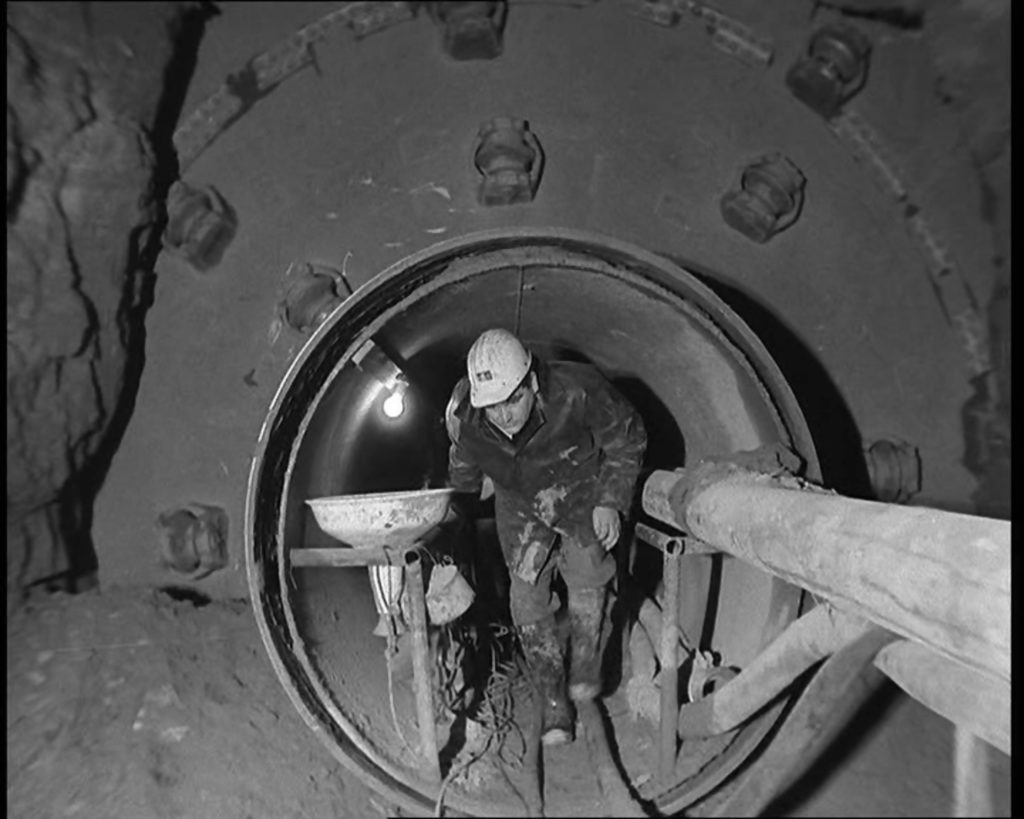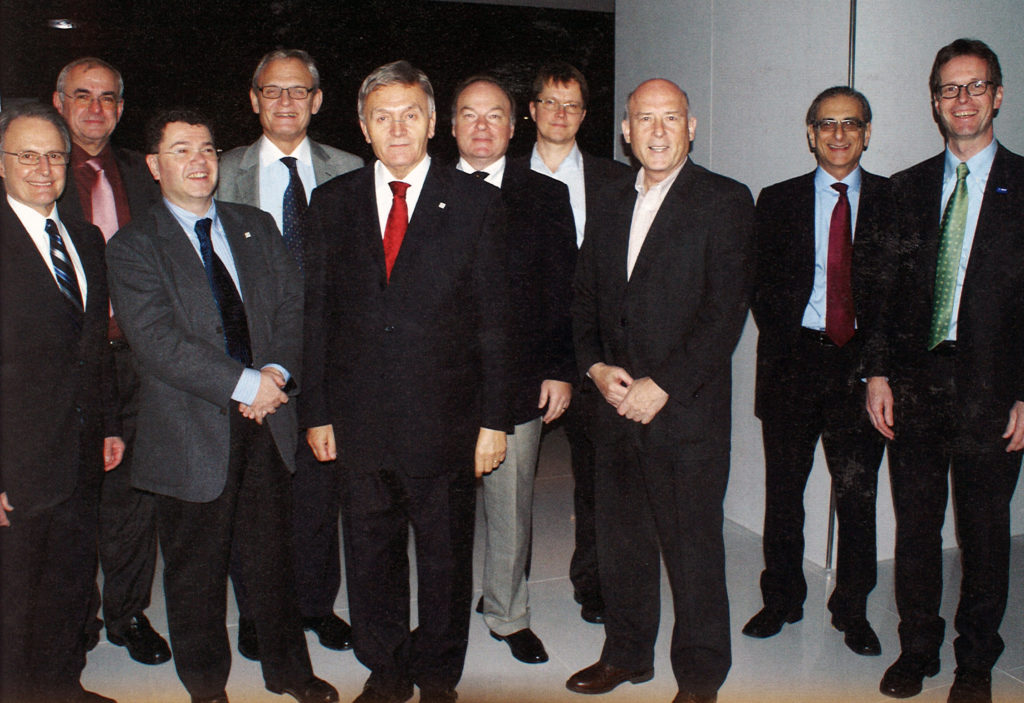Blog
The Changing Face of the Tunneling Industry: The Role of the ITA, Partnership, and Innovation
Martin Knights graduated with a degree in Civil Engineering in 1970 and joined the Second River Mersey Road tunnel project as a site engineer in Liverpool, UK as his first TBM project. The major feature of this 2.5 mile long twin tunnel project was the refurbished 35 ft diameter Robbins TBM, which had previously driven a number of water supply tunnels at the Mangla Dam in Pakistan. Knights worked in several consultancy firms on a number of high profile tunnelling projects over several decades, most recently as the Managing Director and Sr. Vice President for CH2M/Halcrow. He was also president of the International Tunnelling Association (ITA) from 2007-2010. He is currently an independent consultant with his own company, Martin Knights Consulting.

A worker exits the rebuilt Robbins TBM used on the Mersey Road Tunnel Project in the UK. The Second Mersey Road Tunnel was Knights’ first project after graduating in 1970. Image Credit: British Pathé
At the recent ITA Training Course in Bergen, Norway, which preceded the World Tunnel Congress, I gave a lecture about the development of Soft Ground TBMs from Victorian times until now. It took a bit of research: I trawled through reference books and talked to experts in the TBM world. During the research I looked at project specifications for big projects carried out in the past 40 or so years, and was struck by the level of technical detail and requirements that engineers stipulated in the contract documents: there seemed to be a tendency for over-specification that imprisoned the contractor and his equipment suppliers to past tried-and-tested practices. Where was the opportunity to innovate and trial new ideas by those best suited to introduce best and new practices?
That reminded me of Lok Home’s [Robbins president] challenge to me in November 2009 at the Hamburg, Germany STUVA Exhibition and Conference. Lok and l, and other colleagues in ITA and the tunnelling world, took part in an industry round table talk. I was President of ITA then and the two-hour discussion concluded with Lok asking me, “So, Martin, what can I and the industry do for ITA? We provide sponsorship to ITA, like other leading tunnelling companies; we fill the exhibition halls; we host social gatherings during ITA conferences, and we give lectures promoting new products. But we as equipment manufacturers and suppliers want to play a bigger technical role.”
Stung by the realisation that ITA had, by default, missed a trick, and was, in effect, excluding the very talent that provided innovation in tunnelling, I set about forming the then-new ITA technical forum ITAtech. I say “I”, but in fact myself, Lok, Tom Melbye of Normet, Felix Amberg of Amberg Engineering, and colleagues from Herrenknecht, Mapei, Atlas Copco, and others set out over three months to prepare the ground to launch ITAtech as a premier promoter within ITA of technology and innovation. Our purpose was to prepare independent and commonly-agreed technical guidelines and evidence endorsed by the whole international tunnelling industry, which is what ITAtech continues to do. It provides manufacturing, installation, equipment and materials guidelines for Contractors and Designers and creates confidence for tunnel owners that the “brand” of the ITA is overseeing this important knowledge transfer.

The initial 2009 meeting that led to the ITAtech forum. Left to right: Bill Hansmire, Gerhard Robeller, Olivier Vion, Gunnar Nord, Martin Knights, Brian Fulcher, Pekka Nieminen, Lok Home, David Caiden, Daniel Ruckstuhl
As I talked to the Bergen delegates this year, it was obvious to me that soft ground urban tunnelling owes a debt to the development of TBMs over the past 40 years…and particularly to the past 10 years. We can now do things that were too difficult to do way back then. It’s no coincidence that the innovations in the last 50 years were led by TBM companies like Robbins, Lovat, Seli, Herrenknecht, etc. The leadership and pioneering spirit could have only been driven by the individual passion that comes from a “family run” business. With time, growth and ownership has been passed on, but the stewardship and spirit of innovation in tunnelling lives on. ITAtech has tried to capture that spirit. Membership of its Steering Board and Activity groups relies on that desire of industry to educate, improve and share.
A recent President of the UK Institution of Civil Engineers compared our fragmented industry processes with the manufacturing, aircraft and car industry. In effect he said “Why–unlike those industries–do we separate inception, planning, and design from assembly, installation and construction?” The infrastructure and mining industries rely on so many processes and partnerships to deliver projects precisely because they are so fragmented and siloed.
Contemporary procurement encourages more partnerships, but this doesn’t make it any less convoluted. We see the rise of the dreaded words “industry supply chain” and “second and third tier partners”, where it strikes me that we’re airbrushing out the identity of the very “tier” of industry that has to innovate and provide the substance that nourishes the technical solutions that feature in new infrastructure developments.
I suggest that owners and clients get better access to and value from these innovating “tiers”—in many cases the equipment manufacturers and suppliers. In so many cases I have seen technical solutions get misinterpreted as ideas and solutions move up and down the so-called supply chain, begging for recognition, understanding and realisation of value.
I’m sure that this is not intended…but it happens. By validating and bringing innovations to the forefront through organizations like the ITAtech, we can improve some of the convoluted procurement and technical approval processes. However if we want to continue to see advancements like we’ve seen in urban soft ground tunnelling in recent decades, we should seek to streamline manufacturing and procurement, and to work closely with all “tiers” involved—second, third, and on up.
Martin Knights
Recent Posts
- Tunneling in Turkey: The Esme Salihli Railway
- Incredible India: Machines on the Move in Agra and Delhi
- Notice of Retraction and Apology
- Four Things You Need to Know about Probe Drilling and Pre-Grouting
- The Latest Updates: Records in Toronto, the News from Nepal, and More

 Close
Close  Menu
Menu 